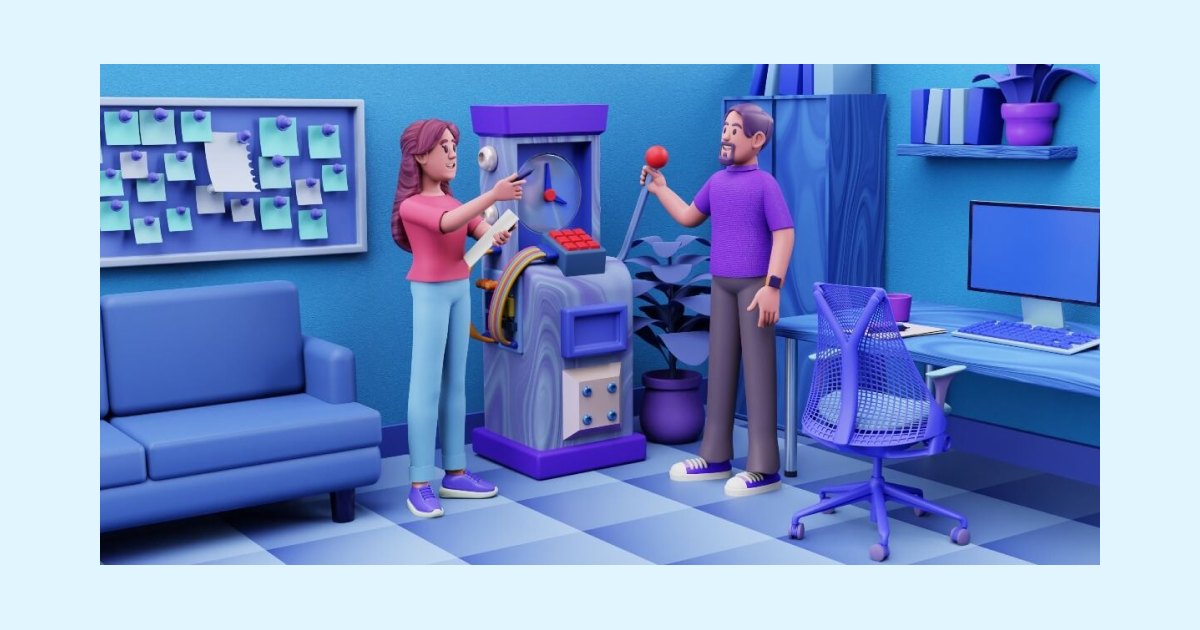Toxic work environment: red flags and survival tips
Last updated on: May 11, 2023
“Pleasure in the job puts perfection in the work.” — Aristotle.
A recent study by MIT Sloan showed that a toxic work culture presents the most common reason why employees quit their jobs!
A toxic workplace can be a breeding ground for negativity, stress, and conflict. It could lead to decreased productivity and morale, and even have serious consequences on an employee’s physical and mental health.
Thus, it’s important to recognize the signs of an unhealthy workplace and take steps to protect yourself and your career development.
But how can you tell if your workplace is toxic? Is there a way to deal with a toxic work dynamic?
That’s what we’re trying to explore in this article, by shedding light on::
- What a toxic work environment is,
- Signs of an unhealthy workplace,
- How toxic work environments affect employees, and
- How to deal with unhealthy workplace dynamics.

Table of Contents
What does “toxic work environment” mean?
Based on today’s comprehension of the term, a toxic work environment is one where employees find it difficult to work or progress in their careers due to the negative atmosphere created by coworkers, supervisors, or the company culture itself.
To help you better understand this term, I asked Annie Morris, Editor in Chief at Made in CA, to provide her input on what qualifies as a toxic work environment:

“An unhealthy workplace is one where people are always on edge. The environment is tense, and there’s a lot of pressure to perform. People feel like they have to be perfect all the time, and if they make a mistake or don’t do something right, they’re afraid that they’ll lose their job or get passed over for promotions.”
However, a toxic workplace didn’t always have the meaning it has today.
Namely, before the 80s, certain work environments exhibited literal toxicity risks in the form of cancerous chemicals and infectious microbes. In the 80s, the meaning expanded to include workplace behavior and regulations, too.
The word “toxic work environment”, with the meaning we recognize today, became popular after Virginia K. Baillie’s book Effective Nursing Leadership: A Practical Guide.
The purpose of the book was to shed light on the poor work environment nurses faced every day. She revealed the rules that dictated how nurses had to behave — to have the leadership skills of a man and the caring demeanor of a woman — and explained how harmful they were. Guidelines like those were so strict, they created unhealthy work environments, on top of sexism and discrimination.
7 Signs of a toxic workplace
A 2022 Work and Well-being survey, conducted by the American Psychological Association, showed that 18% of workers characterize their place of work as “somewhat or very toxic.” What’s more, 30% of employees experienced some form of harassment or abuse in their company or outside of it.
A workplace rarely becomes damaging for the employees on its own or out of the blue. There are certain factors that contribute to it. As they build up over time, they culminate in a very unstable atmosphere and greatly affect the quality of work life.
Baillie’s guidebook names all of the factors that create a toxic work environment. We used it to put together a list of 7 signs of a toxic workplace:
- Unclear company goals and values,
- No respect from the management,
- Employee satisfaction is irrelevant,
- Unclear and undefined roles,
- No room for growth,
- Poor relationships between employees, and
- Conflicts are not handled properly.
Sign #1: Unclear company goals and values
Clear goals are essential for a healthy and productive work environment. When everyone understands the company’s objectives and their own role in achieving them, it can foster a sense of purpose and motivation.
A healthy work environment has openly expressed and discussed:
- Values,
- Attitudes, and
- Beliefs.
Everyone is aware of what the company culture is within the workplace, and new candidates learn about it ahead of time to ensure they feel like the best fit.
On the contrary, in a toxic work environment, it’s never really clear what the company culture entails. Values and beliefs are obscure and rarely discussed.
Additionally, toxic workplaces may prioritize growth or customer satisfaction over the well-being and needs of their employees, leading to unhealthy levels of stress and pressure. This can create a negative and unsupportive work atmosphere that undermines employee morale and well-being.
For example, let’s imagine a manufacturing company without any organizational goals clearly outlined, which leads to a lot of confusion among employees. What’s more, the company lacks core company values that employees can follow.
As a result, employees have a hard time understanding how their work fits into the larger mission of the company, which later leads to low morale and a lack of motivation, as stated above. Furthermore, the lack of direction causes inefficiencies in the production process, such as wasting resources and slower production in general.
Questions to ask yourself to check whether your company has defined core values
If you aren’t sure whether your workplace has clear core values all employees understand, here are some questions to ask yourself:
- Do all employees know what the bigger picture is, aside from company growth?
- What kind of values does the company want to instil?
- Is your company succeeding at following and promoting its values?
Sign #2: No respect from the management
Respect is essential for a healthy work environment. Employees can either be treated as valued workers or as nothing more than a resource to be managed.
In a healthy work environment, decisions are made collaboratively, with input from all concerned parties. Respect in the workplace fosters a sense of teamwork and support and ensures that all perspectives are considered.
On the other hand, toxic workplaces may lack transparency and collaboration, with decisions being made unilaterally by higher-ups without input or consultation from others. This can create a sense of power imbalance and undermine employee autonomy and creativity, leading to a negative work atmosphere.
In an unhealthy environment, employees will often feel like their supervisors and managers use them as tools to get the job done. They’re moved around from department to department, constantly changing their roles based on the task that needs to be done next.
Rudeness and lack of respect, which are common traits of a toxic workplace, have a large impact on employees’ satisfaction and productivity.
According to research conducted by professors Christine Porath and Christine Pearson, hostility and rude behavior managers exhibit make employees much less motivated. In fact, about 80% of the workers who experienced uncivil behavior in the workplace spent their working hours worrying about that situation instead of working. In addition, 48% of the respondents deliberately put in less effort in their work, while 12% resigned from their positions due to hostility at work.
Aside from interpersonal respect, the lack of respect in the workplace may also include other aspects such as:
- No respect in communication, and
- No respect in expressing feelings.
No respect in communication
A healthy environment supports open, assertive communication. Proper communication is based on an understanding of previously mentioned roles, goals, attitudes, and beliefs. Knowing the roles and hierarchy of each person helps achieve better results.
In a toxic environment, communication is one-sided. Employers and supervisors use it as a tool to assert dominance or as a power struggle.
In such an environment, communication can be passive-aggressive or simply passive or aggressive:
- Passive-aggressive communication — Expressing dissatisfaction without openly saying it (eye-rolling, crossing arms, sarcasm, gossiping, and plotting),
- Passive communication — Avoiding conflict and communication altogether, or
- Aggressive communication — Emotional outbursts, asserting dominance over the conversational partner.
A lack of respect is obvious in a manager who uses abusive language or engages in physical intimidation when interacting with employees. Employees frequently feel uncomfortable, intimidated, and disrespected. Over time, they stop trusting their manager, become much less motivated, and are extremely stressed and anxious when they have to come to work.
Moreover, communication issues go hand in hand with an unhealthy work environment, according to Simo Jokic, a Talent Acquisition Specialist at COING. Simo further explains:

“Regardless of whether the improper communication is on the horizontal or vertical line of hierarchy, this problem must be approached with care considering that it consequently leads to many disturbances in the dynamics and quality of the organization.”
No respect in expressing feelings
Contrary to what many may believe, expressing one’s feelings should be welcomed in the workplace, so long as it is done in an assertive, respectful manner. That will create a sense of transparency and support, and will allow employees to address any issues or concerns they may have.
On the other hand, within a toxic work environment, employees have to take everything in their stride. There is an overall fear of expressing themselves due to the backlash from other employees or supervisors. This leads to bottled-up frustrations that can cause a loss of focus, a drop in productivity and satisfaction in the short term, and mental and physical health worsening in the long term.
Let’s say that there is a small retail store where the manager has a strict “no complaints” policy. Employees can’t express their concerns or frustrations and have to maintain a positive attitude at all times.
As a result, employees may bottle up their feelings and not express their concerns about issues such as poor working conditions, inadequate training, or mistreatment by customers. This can lead to resentment, low morale, and high turnover among the employees, creating a toxic work environment.
💡 Clockify Pro Tip
Suppressing feelings can lead to emotional labor, which could cause burnout, fatigue, exhaustion, and even depression. Learn more about emotional labor here:
Questions to ask yourself to check whether your workplace lacks respect
Let’s go over some questions that will help you verify whether your workplace lacks interpersonal respect, respect in communication, or respect in expressing feelings:
- What is the communication like between employees and supervisors/bosses?
- Do your managers and supervisors talk amongst themselves?
- How are failures and successes treated?
- Are your and your coworker’s opinions validated?
- Do you feel gaslit in your place of work?
- Is your supervisor addressing you in a condescending tone?
Sign #3: Employee satisfaction is irrelevant
Employee satisfaction presents the extent to which an individual is satisfied with their job. It is a vital factor that affects the success of the whole company as well as the turnover rate.
A healthy work environment ensures that workers feel appreciated at their workplaces. What’s more, employers commend keeping a good work-life balance and resting properly.
On the contrary, an unhealthy work environment often doesn’t support work-life balance or rest. Employees are made to feel as though sick days and holidays are a hindrance to the company’s progress, rather than an opportunity for them to recharge. As a result, they might end up being overworked or burnt out.
Imagine a tech startup where employees need to work long hours and be on call 24/7. The company culture praises the idea of “hustling” and “grinding”, and the management expects employees to be constantly available to work on new projects — even if it means sacrificing their personal and family time.
In this scenario, employees have to put up with long hours and are frightened to ask for time off or adequate compensation for working overtime. That often leads to burnout, fatigue, and poor mental and physical health.
Questions to ask yourself to see how your company values employee satisfaction
You can ask yourself these questions to check if employee happiness is valued in your workplace:
- Are people being guilted or scared into working longer hours to meet certain milestones?
- Do your supervisors make you feel guilty when you want to take a day off?
- Do employees frequently quit and then come back to work for the company?
Sign #4: Unclear and undefined roles
Ensuring that roles are clear and communicated effectively is crucial for building a positive and supportive work environment.
When an employee is aware of their role and responsibilities, not only do they know what their job entails, but also what is expected of them, and what counts as a success or failure in their tasks. Once the lines get muddled, a person can gradually lose sight of which tasks or behavior help push them forward in their career.
A toxic workplace may lack clear goals or fail to communicate them effectively, leading to confusion and frustration among employees. Employees will then have difficulty understanding their career path and how to contribute to the company’s success, leading to a negative work atmosphere.
This situation tends to evolve in smaller or growing companies that don’t have enough manpower to cover all aspects of the business.
However, it is also seen in big businesses where roles are given and taken away on a whim by the management, to patch up poor leadership, or where responsibilities are not clearly divided among team members. Workers may feel unsure of what they should be doing or who they should report to. What’s even worse, some employers choose to give additional roles to their employees, most often without proper financial compensation.
Questions to ask yourself to check whether your workplace has unclear and undefined roles
These questions will help you in understanding whether your place of work has provided clarity when it comes to your role and responsibilities:
- Do your responsibilities differ from the initial job requirements in the job posting?
- Are you frequently required to perform tasks outside of your scope?
- Do you regularly feel like you’re doing other people’s work?
Sign #5: No room for growth
Personal growth is essential for any employee. In a healthy environment, supervisors provide thorough feedback and allow for more decision-making autonomy to help employees grow.
While there should be guidelines for completing tasks, employees can freely move within them, and make their own day-to-day decisions. The more independent they are, the better the results.
In a toxic work environment, there is only a single way of doing things, and it’s usually decided by one person or by the higher-ups. Their method is reinforced constantly, and there is little to no room for experimentation.
Such practice leads to numbness, loss of motivation, and a growing feeling of being nothing more than “a cog in a machine”.
Employees may feel that there is no incentive to improve their skills or to work harder:
- In companies with few opportunities for training and development, and
- In companies where promotions are based on seniority rather than merit or qualifications, as there is no clear path to advancement.
💡 Clockify Pro Tip
Looking for a way to stay motivated? Read this motivation guide:
Questions to ask yourself to verify the importance your workplace gives to growth
To examine whether your company values personal growth, ask yourself the following questions:
- Are you and your coworkers pushed to experiment?
- Can you pursue alternative methods of getting the tasks done?
- Are creative freedom and resourcefulness encouraged?
- Is there regular feedback?
Sign #6: Poor relationships between employees
Employee relationships are essential for fostering a healthy work environment.
Toxic coworkers can contribute to a negative work atmosphere and make it difficult for others to do their jobs effectively. Some behaviors that may indicate a toxic coworker include:
- A sense of entitlement,
- Values that are incompatible with the company’s values,
- Forming cliques or excluding others,
- Selfishness,
- Gossiping and spreading rumors,
- Passive-aggressiveness,
- Oversharing personal problems, or
- Taking credit for others’ work.
Your coworkers may not be toxic, but your dynamics can be. A dysfunctional work environment can promote the suppression of feelings and avoiding discussions. As a result, dynamics between you and your coworkers could become toxic over time.
The value of coworker relationships was highlighted in a paper published in the Journal of Cognitive Sciences and Human Development on the topic The Relationship Between Working Environment and Employee Performance. The paper explored the value of different workplace aspects to employees’ performance. It emphasized that a good relationship with coworkers increases motivation and a sense of obligation to the company, which makes employees complete their tasks more diligently.
Questions to ask yourself to determine the state of relationships between employees
These questions will help you find out how connected employees are in the company:
- Observe people around the office, how do they act?
- Do your coworkers communicate, smile, and talk casually every now and then?
- Is everyone at the office tense and easily agitated?
- Is there a sense of togetherness, a community?
- Is a healthy discussion welcome?
Sign #7: Conflicts are not handled properly
Conflicts are simply disagreements in approach, attitudes, or opinions. They are a normal and natural part of any work environment. However, it’s important that they are handled in a healthy and productive way.
A healthy work environment doesn’t shy away from conflicts. People are able to communicate openly and assertively and always keep the resolution in mind. The end goal is to find a win-win solution.
Contrarily, a toxic work environment tends to ignore conflicts. The employees aren’t taught how to respond to them, so they turn into arguments that need to be won.
Liz Kislik, a management consultant with over 25 years of experience, believes that conflicts are never just disagreements between two people in the office. She claims that they are the surface indicator of bigger problems within the company itself.
A relatable example could be a company that has a management culture where conflicts are viewed as an indication of weakness, and where conflicts are seen as a sign of poor teamwork. Employees are reluctant to express their differences to avoid conflicts, even when these conflicts are healthy and could make the team more effective in completing tasks.
Questions to ask yourself to see how your place of work deals with conflicts
Here are some questions to help you determine if your workplace handles conflicts well:
- Is discussion praised at your workplace?
- Do your supervisors encourage staying away from potential disagreements?
- Are you reluctant to express differences with your coworkers or supervisors?
Red flag phrases that showcase a toxic work environment
Unhealthy work dynamics can sometimes be difficult to recognize or understand.
Simo Jokic provided his input regarding workplace red flags as well. He believes that a toxic work environment could be hiding behind some phrases which may sound innocent to an employee.
Some of them are:
- “We are all one big family”,
- “Be prepared to work under pressure”,
- “We’ve had colleagues that were ungrateful for the opportunity we gave them”, or
- Constantly highlighting the importance of “loyalty” for the employees.
To make things a bit easier for you, we’ll cover some red flags you should watch out for at your workplace, so you can establish whether you’re dealing with toxic work dynamics. In addition, we’ll help you avoid working in this kind of environment by naming essential red flags to keep in mind during interviews!
Signs of a toxic work environment at your workplace
Toxic situations stem from toxic phrases.
Annie Morris also helped us identify a toxic workplace and pointed out crucial red flag phases to watch out for:

“If you’re hearing phrases like “we’ve never done it this way before,” or “we don’t have the resources to do that,” or even “this isn’t how we do things around here,” then you have a problem. These are all red flags that signal a lack of vision, and the beginning of an unhealthy workplace.”
Toxic phrases are usually the first clear-as-day indicator that you’re in a bad environment. Here’s a list of the most commonly heard examples.
“Who is the manager here, me or you?”
This statement doesn’t offer any explanation or reasoning behind a specific decision. Instead, it has the purpose of asserting dominance.
“I’ve been here longer than you to know that… “
Another statement that is supposed to assert dominance and get you to do work someone else’s way.
“Can you take your holiday at a later date? This period is really important for the company”
Your rest time is not up for debate. Holidays and sick leaves are what keeps your mental health in check. While you should be mindful to not leave the office with a pile of unfinished work, no supervisor can ask you to press pause on your private life for the betterment of the company.
“If you don’t want this job, there’s always someone who will gladly take your place”
This phase is less heard by supervisors due to its directness. You’ll most commonly get this comment from a coworker, masked as a well-meant “reality check”. It is there to make you stop voicing any negative opinions or doubts about how the workplace is handled.
“Stop making excuses and just do what you were asked to”
If you have legitimate concerns about a task, then they’re not excuses. This kind of comment comes from the idea that employees should listen to their supervisors without fail, and never question their authority.
“Work is not supposed to be fun — that’s why they call it ‘work’”
Work should be engaging and challenging. It should feel rewarding. Viewing work as torture or a chore could only contribute to toxicity and dissatisfaction.
“I don’t like your attitude”
There is a difference between having an attitude and standing up for yourself. Learn when your higher-ups are trying to shut you down because they can’t handle valid criticism.
“We/They can replace you just like that, so I’d watch it if I were you”
This is an intimidation tactic supervisors use to keep people in line. Supervisors know people need their jobs and will resort to threats typically calling them “reality checks”.
“Look at _____, she’s also having personal problems/difficulties at work, and she’s not complaining!”
Just because a coworker doesn’t practice self-disclosure, it doesn’t mean no one should. These remarks serve to stifle individuality and kill any attempt of pointing out poor office practices.
💡 Clockify Pro Tip
Whenever you’re in doubt about what counts as oversharing, and what is self-disclosure, discuss it with yourself first, and then make a decision. You can learn more about oversharing and staying focused during personal crises on this link:
“It is not my fault, _____ was supposed to do X/Y but he didn’t deliver!”
Constant pointing of fingers reveals a deeper issue — the employees are afraid of repercussions and taking responsibility. Instead of focusing on working out a solution, employees focus on finding the culprit or dissecting the mistake.
“If no one complains about your work — it means you’re doing fine. Just keep working”
While not outwardly a toxic sentence, it packs a lot of hidden ticking time bombs. The employees will subconsciously wait for the moment when a negative comment arrives. Moreover, this kind of statement is a way for supervisors to avoid the additional tasks of tracking their employees’ progress and giving regular feedback.
Interview red flags that showcase bad work culture
You can avoid working in an unhealthy environment by watching out for the most common red flags during the hiring process.
Job ads pop up quite often
This could be a sign of a lot of people quitting or getting fired on a regular basis.
The hiring process moves too fast or takes too long
Moving too fast may be a sign that your company is not taking hiring capable candidates seriously. On the other hand, waiting too long for an answer might mean that you aren’t among the company’s first choices so you are left waiting without any information.
The recruiters/employers seem aloof and indifferent
They ask very little about you, your ambitions, and your plans, mostly focusing on what you have achieved and what you can do for them.
The recruiters/employers don’t look like they want to sell you on the job
It seems as though they would be fine either way. This is a sign of a disinterested workplace that could care less about where your career goes.
The recruiters/employers keep reminding you how numerous candidates applied for the same job
It’s a tactic to get you nervous and accept a lowball offer.
The recruiters/employers ask you questions that show they have no idea what your job entails
In this kind of workplace, you will probably have switched roles, not know what your goals are, or won’t receive proper feedback.
The recruiters/employers keep pointing out how rewarding hard work is
Sentences such as “We work hard, we play hard” tend to glamorize overworking. Sugarcoating is the most likely common practice of making employees work overtime. There are actually laws that regulate work hours, especially overtime. Californian regulations are among the most notable ones, so looking up if there are similar ones in your country could be helpful.
💡 Clockify Pro Tip
Navigating employment law can be tiring! You can read the following guides to stay informed on the latest labor regulations in the US:
The recruiters/employers avoid answering questions about work hours, promotions, or growth opportunities
There is no established way of progressing, and they are most likely offering promotions and bonuses “on the fly” and without structure.
Toxic workplace and mental health
When you aren’t working in a healthy environment, you can lose any sense of self-awareness. Moreover, a toxic workplace could make you doubt your skills and talents, and you can start downplaying everything you do.
How working in a toxic environment can impact mental health
To get more insight into dealing with toxic workplace dynamics, I have contacted Heidi Cox, the Founder & Clinical Director at the Centered Space Psychology Group. She says:

“In work cultures where you are constantly trying to satisfy a critical boss, or given little rewards for big efforts, you are more likely to experience dissatisfaction, low self-esteem, and depression, to name a few.”
Simo Jokic provided his input as well:

“People spend a lot of time at work and need that aspect of their lives to be at least satisfactory. Long-term exposure to stress can lead to many mental problems such as depression and anxiety, and therefore it is important to recognize a bad work atmosphere, and if it is too harmful, leave it. Constantly working on yourself and developing resilience to stress can be useful in dealing with this issue.”
The Internet is full of articles that confirm the impact that unhealthy work environments have on our mental well-being. A recent article by Forbes mentions that hostile or dangerous working conditions may result in chronic stress.
Moreover, in a 2022 survey on workforce mental health, 37% of employees claimed that work-related issues, such as stress and burnout, affected their mental health. The research also states that work-related issues affect employees’ mental health more than economic uncertainty (32%) and family and relationship issues (30%).
Can a toxic work environment make you depressed?
The answer is — yes, absolutely. Longer exposures to toxic workplaces can lead to depression, as shown in the study on predicting work-related depression symptoms.
This study lasted for a full year and was conducted by the University of South Australia. It showcased that poor management practices lead to a higher risk of depression among workers. In addition, full-time employees that work at companies that don’t prioritize their mental health are three times more at risk of being diagnosed with depression.
How to tell if a toxic workplace is affecting you?
Operating within unhealthy workplace dynamics can cause significant long-term consequences, including career burnout. We might be used to these dynamics, but that doesn’t make them normal or okay.
To avoid falling into this trap, we’ve made a “health checklist”:
- How are you sleeping? Do the hours of rest vary from your usual schedule? For how long has this been going on?
- Do you have any physical pain or discomfort at the thought of going to work, or during your commute?
- What is your appetite like? Does it differ from the norm?
- Do you feel a sense of dread at times, like something bad is about to happen? Does it happen at work or at home?
- Do you feel drained and exhausted more often than not (despite sleeping well)?
- Are you experiencing sudden abdominal pain, or have increased headaches?
- Are you having difficulty remembering even the smallest things like names, dates, and so on?
- Do you feel you’ve grown intolerant, or more easily agitated? Do you snap at friends and family more easily?
NOTE: This checklist is by no means a medically-approved way of diagnosing yourself with anxiety, depression, or other illnesses. It is merely a guideline to question yourself and can be helpful when checking in with your doctor. If any serious ailments are bothering you, turn to a licensed physician.
If you’ve answered yes to quite a few of these questions, you have suffered the consequences of a toxic work environment.
The best course of action would be to talk to your physician and consider the next steps. It’s essential that you react as soon as possible as the stress you’re experiencing could cause irreversible damage.
Is a toxic work environment legal?
An unhealthy workplace can be detrimental to a person’s health. But can you build a court case around it?
Sadly, no. And here’s why.
A company can be considered to have violated the law in case there were:
- Discrimination based on race, disability, gender, age, religion, and sexual orientation,
- Sexual harassment (verbal or physical), and
- Failure to address all allegations and concerns of discrimination or harassment.
For a company or an employer to be liable for legal action, they need to make a fairly severe transgression. If you don’t have clear proof of serious transgressions, building a legal case would be challenging.
Toxic work environment lawsuit
The regulations on toxic workplace lawsuits differ across the globe. But, in most cases, the circumstances of mental and emotional distress need to be so severe, that a sensible person cannot cope with it.
For a complaint to be valid in the US court, there are a few things that need to be proven. Namely:
- That the employer acted intentionally or recklessly,
- That the employer’s behavior was extreme and outrageous,
- That the behavior was the cause of distress, and
- The distress was severe.
Unfortunately, very few complaints fulfill these four requirements. Moreover, even if they do, severe distress that is a direct consequence of your employer’s wrongdoing is extremely difficult to prove.
How to deal with a toxic work environment
You are now aware of all the harmful effects of a toxic environment as well as that it’s difficult to take legal action to protect yourself from unhealthy work dynamics. But that doesn’t mean there isn’t anything you can do.
Here are some practical tips that will provide some comfort when dealing with unhealthy workplace dynamics:
Tip #1: Focus on things you can change to feel better at work
Heidi Cox provided a piece of advice on handling a toxic work environment:

“When working in a toxic environment, it is important to remind yourself of the things you can change and the things you cannot change. Sometimes systemic issues stand in the way of job satisfaction and are difficult to change. Instead, it might make sense to focus on things you can do like set work boundaries, put up out-of-office reminders while on vacation, don’t answer emails outside of work hours, and even talk to your boss about issues that are upsetting you.”
Tip #2: Find out whether your actions play a part in a toxic work environment
Simo Jokic has valuable advice to share with anyone dealing with a toxic workplace:

“An individual should try to analyze their actions and assess whether they contribute to a toxic atmosphere. Furthermore, they have to be agile and flexible, try to focus on the positive aspects of their work, find people with whom they have good communication and cooperate with them, try to communicate openly, etc. All of the above makes sense if staying in a toxic atmosphere does not pose too great a risk to mental health.”
Tip #3: Try to solve the issue by talking with coworkers
If the problem is with your coworker, try to talk it out. Be assertive and try to speak from a place of understanding.
You should keep in mind that conflicts are not inherently negative, it’s our reactions to them that cause a problem. You can do what you can to solve the issue and leave the rest to the other party.
Tip #4: Confide in friends and family
Your friends and family should be your first go-to people when you establish that your workplace is toxic, especially if you don’t know who you can trust in the office.
Your loved ones are often the first to notice that something is wrong with your work life. You should lean on them, and share your struggles, then ask for an objective opinion.
Tip #5: Seek support in the office
If you do have work friends, and you have each other’s best intentions at heart, then you’re one step further towards solving the issue. Together, you can discuss the workplace atmosphere, let off some stress, and document incidents and events in case you need proof.
A little note of caution, however — if your group mainly discusses work-related issues and stresses over how bad things are, it very quickly becomes damaging. You are rekindling the flames over and over, instead of finding ways to combat the issue or let it go.
Tip #6: Document everything you do
It’s better to be safe than sorry.
Whenever you get a gut feeling that someone’s tone is malicious, toxic, or aimed at berating you, document it. It may seem extreme, but it could be a useful ace up your sleeve if things start to go south.
Furthermore, it’s wise to file or voice your complaints and concerns via email. That way, you will make sure that you have written proof of every conversation that took place.
Tips on gathering proof:
- Do it immediately after an unpleasant event, or a conversation,
- Note repeating behaviors that you have observed,
- Add dates and times,
- Screenshot emails and chat exchanges, and store them somewhere private and safe,
- Describe situations in as much detail as you can and remain objective, and
- Track how you spend time at work and identify early on if you’re wasting any time or if your productivity has dropped.
Tip #7: Familiarize HR with your issue
In case you think that confronting an issue or a person will only add fuel to the fire, it is best to talk to a neutral party.
If there is no HR department, you can express your concerns to your employer, or supervisor. You could ask for discretion and anonymity if you are afraid of retribution.
Tip #8: Balance out the bad with the good
If you don’t know how to fix a toxic work environment, you can at least try to lead a healthier lifestyle outside of work. You could focus on your hobbies or spend more time with your family. Here are some ideas:
- Organize or sign up for events throughout the week you will look forward to,
- Don’t work overtime more than absolutely necessary,
- Don’t multitask,
- Don’t resort to alcohol or over-the-counter medication,
- Listen to your favorite music or watch soothing videos when you get home,
- Take long showers or baths,
- Journal your thoughts, allow the frustrations to get out on paper (this helps verbalize your thoughts and clears your mind of them), and
- Go for an intense physical activity.
Self-care varies from person to person. So, find what little self-indulgent activities work best for you and start doing them regularly.
Tip #9: Leave the company
Sometimes the best course of action is leaving a toxic work environment. It’s better to leave on time than risk irreversible health consequences, as your mental and physical health are priceless!
To make the process of leaving your workplace less stressful, you should create a plan of action.
Firstly, it’s wise to check your employment contract and see whether there are any conditions you have to fulfill before you resign from your position.
Then, you can start researching your options and applying for other jobs.
To sum up: A toxic work environment affects motivation, success, and mental health
Toxicity in the workplace is more common than ever. Whether overt or subtle — it causes physical and emotional stress to the employees. What’s more, it costs employers money due to drops in productivity and sick leaves.
To combat the issue, an effort has to be made on creating a supportive environment at work and outside the workplace. While one person can’t make an entire company a better place, they can at least ensure their well-being stays intact.
✉️ Do you suspect that you might be dealing with a toxic work environment? Feel free to share your experience with us at blogfeedback@clockify.me. Also, if you liked this article, be sure to spread the word to your friends and colleagues!





